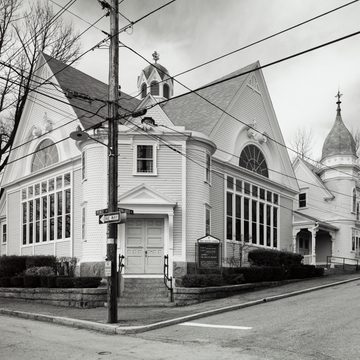Queen Anne design typically alters the expected scale of colonial ornamentation. Here the alteration is excessive. On the two principal elevations for the corner location, ranges of tall windows are topped at their centers by semicircular openings to suggest giant Palladian elements. Bloated broken scroll motifs topped by diminutive urns surround the semicircles. The entrance occurs at the corner, which was originally capped by a steeple. The loss leaves a mini-cupola over the center of the church as its “tower,” plus another octagonal turret on Melrose Street as the compositional anchor for a picturesque cluster of windows at the entrance to the attached parish house.
The space inside seems influenced by both the seventeenth-century square-plan preaching box and the nineteenth-century preaching

